Related Research Articles
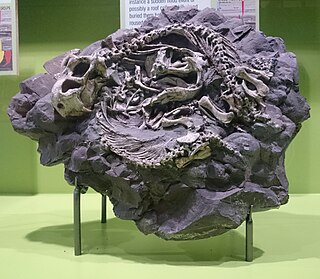
Dicynodontia is an extinct clade of anomodonts, an extinct type of non-mammalian therapsid. Dicynodonts were herbivores that typically bore a pair of tusks, hence their name, which means 'two dog tooth'. Members of the group possessed a horny, typically toothless beak, unique amongst all synapsids. Dicynodonts first appeared in Southern Pangaea during the mid-Permian, ca. 270–260 million years ago, and became globally distributed and the dominant herbivorous animals in the Late Permian, ca. 260–252 Mya. They were devastated by the end-Permian Extinction that wiped out most other therapsids ca. 252 Mya. They rebounded during the Triassic but died out towards the end of that period. They were the most successful and diverse of the non-mammalian therapsids, with over 70 genera known, varying from rat-sized burrowers to elephant-sized browsers.
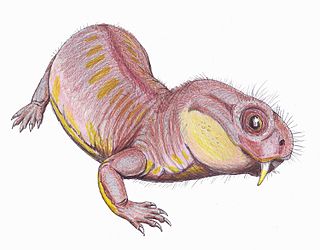
Robertia is an extinct genus of small herbivorous dicynodonts from the Middle to Late Permian of South Africa, between 260 and 265 million years ago. It is a monospecific genus, consisting of the type-species R. broomiana, which was classified by Lieuwe Dirk Boonstra in 1948 and named in honor of Robert Broom for his study of South African mammal-like reptiles.

Diictodon is an extinct genus of pylaecephalid dicynodont. These mammal-like synapsids lived during the Late Permian period, approximately 255 million years ago. Fossils have been found in the Cistecephalus Assemblage Zone of the Madumabisa Mudstone of the Luangwa Basin in Zambia and the Tropidostoma Assemblage Zone of the Teekloof Formation, Tapinocephalus Assemblage Zone of the Abrahamskraal Formation, Dicynodon Assemblage Zone of the Balfour Formation, Cistecephalus Assemblage Zone of the Middleton or Balfour Formation of South Africa and the Guodikeng Formation of China. Roughly half of all Permian vertebrate specimens found in South Africa are those of Diictodon. This small herbivorous animal was one of the most successful synapsids in the Permian period.

Dicynodon is a genus of dicynodont therapsid that flourished during the Upper Permian period. Like all dicynodonts, it was herbivorous animal. This reptile was toothless, except for prominent tusks, hence the name. It probably cropped vegetation with a horny beak, much like a tortoise, while the tusks may have been used for digging up roots and tubers.

Emydops is an extinct genus of dicynodont therapsids from the Middle Permian to Late Permian of what is now South Africa. The genus is generally small and herbivorous, sharing the dicynodont synapomorphy of bearing two tusks. In the following years, the genus grew to include fourteen species. Many of these species were erected on the basis of differences in the teeth and the positioning of the frontal and parietal bones. A 2008 study narrowed Emydops down to two species, E. arctatus and the newly described E. oweni.

Eodicynodon is an extinct genus of dicynodont therapsids, a highly diverse group of herbivorous synapsids that were widespread during the middle-late Permian and early Triassic. As its name suggests, Eodicynodon is the oldest and most primitive dicynodont yet identified, ranging from the middle to late Permian and possessing a mix of ancestral Anomodont/therapsid features and derived dicynodont synapomorphies.

Endothiodon is an extinct genus of large dicynodont from the Late Permian. Like other dicynodonts, Endothiodon was an herbivore, but it lacked the two tusks that characterized most other dicynodonts. The anterior portion of the upper and lower jaw are curved upward, creating a distinct beak that is thought to have allowed them to be specialized grazers.
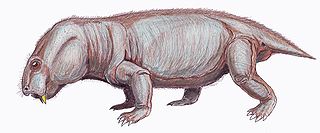
Dicynodontoides is a genus of small to medium-bodied, herbivorous, emydopoid dicynodonts from the Late Permian. The name Dicynodontoides references its “dicynodont-like” appearance due to the caniniform tusks featured by most members of this infraorder. Kingoria, a junior synonym, has been used more widely in the literature than the more obscure Dicynodontoides, which is similar-sounding to another distantly related genus of dicynodont, Dicynodon. Two species are recognized: D. recurvidens from South Africa, and D. nowacki from Tanzania.

Daptocephalus is an extinct genus of non-mammalian synapsid anomodont dicynodont, it which was found in Late Permian strata, in a biozone known precisely for the presence of fossils of this dicynodont, the Daptocephalus Zone, in the Karoo Basin in South Africa. An additional species, D. huenei, is known from the Usili Formation in Tanzania and was formerly assigned to the genus Dicynodon before a study in 2019 recognised that the type specimen belonged to Daptocephalus.
Eurychororhinus is a dubious genus of dicynodont from the Cistecephalus Assemblage Zone of the Karoo Basin, South Africa, and Zimbabwe. It is possibly synonymous with Pristerodon.
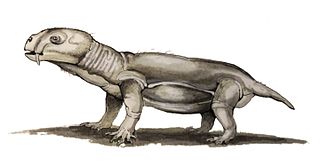
Eosimops is an extinct genus of pylaecephalid dicynodonts. They were small synapsids superficially resembling modern mammals. Eosimops is known from several skull specimens, as well as one complete skeleton. Eosimops lived during the Middle Permian of South Africa.
Kwazulusaurus is an extinct genus of dicynodont therapsid from the Late Permian of South Africa. The type species K. shakai was described from the Dicynodon Assemblage Zone of the Beaufort Group in 2002. It has many similarities with the well-known dicynodont Lystrosaurus, and has been placed in the same family, Lystrosauridae. Kwazulusaurus appears to be transitional between early dicynodonts and the more derived Lystrosaurus; it has the wide skull roof of earlier dicynodonts, and a shortened snout like that of Lystrosaurus.

Odontocyclops is an extinct genus of Dicynodonts that lived in the Late Permian. Dicynodonts are believed to be the first major assemblage of terrestrial herbivores. Fossils of Odontocyclops have been found in the Karoo Basin of South Africa and the Luangwa Valley of Zambia. The phylogenetic classification of Odontocyclops has been long under debate, but most current research places them as their own genus of Dicynodonts and being very closely related to Rhachiocephalus and Oudenodon.

Tropidostoma is a medium-sized herbivorous oudenodontid dicynodont therapsid that lived during the Late Permian (Lopingian) period in South Africa. The first Tropidostoma fossil was described by Harry Govier Seeley in 1889. Later two subspecies were identified. Tropidostoma fossils are an index fossil in a biozone of the Karoo Basin known as the Tropidostoma Assemblage Zone. This biozone is characterized by the presence of this species in association with another dicynodont species, Endothiodon uniseries.

Lystrosauridae is a family of dicynodont therapsids from the Permian and Triassic time periods. It includes two genera, Lystrosaurus and Kwazulusaurus. Kwazulusaurus includes a single species, K. shakai, from the Late Permian of South Africa and Lystrosaurus includes many species from the Late Permian and Early Triassic of South Africa, India, and Antarctica.
Prosictodon is an extinct genus of pylaecephalid dicynodont from Middle Permian of South Africa. It was first named by Kenneth D. Angielczyk and Bruce S. Rubidge in 2010 and the type species is Prosictodon dubei.

Pylaecephalidae is a family of dicynodont therapsids that includes Diictodon, Robertia, and Prosictodon from the Permian of South Africa. Pylaecephalids were small burrowing dicynodonts with long tusks. The family was first named in 1934 and was redefined in 2009. Diictodontidae and Robertiidae are considered junior synonyms of Pylaecephalidae; although Pylaecephalus itself is considered a junior synonym of Diictodon, the name Pylaecephalidae predates these names and therefore takes priority.
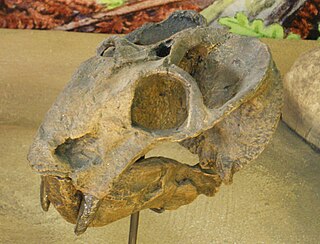
Bidentalia is a group of dicynodont therapsids. Bidentalia was one of the first names used to describe dicynodonts; the group was established in 1876, while the name "bidentals" dates back as far as 1845. With the increasing prominence of phylogenetics, the group was redefined as a clade in 2009. Bidentalia is now considered a stem-based taxon that includes all taxa more closely related to Aulacephalodon bainii and Dicynodon lacerticeps than Emydops arctatus.
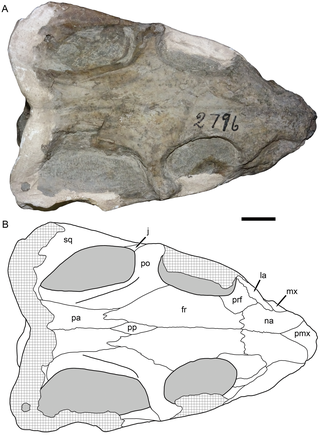
Thliptosaurus is an extinct genus of small kingoriid dicynodont from the latest Permian period of the Karoo Basin in KwaZulu-Natal, South Africa. It contains the type and only known species T. imperforatus. Thliptosaurus is from the upper Daptocephalus Assemblage Zone, making it one of the youngest Permian dicynodonts known, living just prior to the Permian mass extinction. It also represents one of the few small bodied dicynodonts to exist at this time, when most other dicynodonts had large body sizes and many small dicynodonts had gone extinct. The unexpected discovery of Thliptosaurus in a region of the Karoo outside of the historically sampled localities suggests that it may have been part of an endemic local fauna not found in these historic sites. Such under-sampled localities may contain 'hidden diversities' of Permian faunas that are unknown from traditional samples. Thliptosaurus is also unusual for dicynodonts as it lacks a pineal foramen, suggesting that it played a much less important role in thermoregulation than it did for other dicynodonts.
References
- ↑ Munyikwa, Darlington (2001). Cranial morphology of a primitive dinocephalian from the Madumabisa Mudstone Formation, Zimbabwe (MSc). University of the Witwatersrand.
- ↑ Cluver, Michael A.; King, Gillian M. (1983). "A reassessment of the relationships of Permian Dicynodontia (Reptilia, Therapsida) and a new classification of dicynodonts". Annals of the South African Museum. 91 (3): 195–273.





